How to Protect Your Home from Water Damage

Homeowners in the Pacific Northwest are no strangers to precipitation. And while keeping an umbrella and pair of rain boots handy is a fact of life for residents, it is not always so simple to come up with ways to protect your home from the moisture. To help in this regard, the following breakdown looks at 5 of the most effective ways to protect your Seattle-area home from water damage.
Waterproofing

It is important for homeowners to understand the difference between damp proofing and waterproofing. While both processes are similar in their battle to keep moisture away from the home, they do have some important differences.
Damp proofing involves applying a treatment to a material to prevent the absorption of moisture in the absence of hydrostatic pressure. This makes it a good option in humid areas or for subterranean structures where moisture from the soil may be passively absorbed. However, damp proofing may not be enough for structures that are in contact with flowing water.
Waterproofing is a much more comprehensive process. It involves treating a structure to prevent the passage of liquid water in the presence of hydrostatic pressure. For example, waterproofing a foundation would involve applying a waterproof membrane to the outside of the foundation that actively directs flowing groundwater down to a drainage board and away from the structure through a system of pipes. Similarly, creating a waterproof garage floor would involve applying a latex paint to the garage floor that actively repels water dripping off of cars or shoes.
While both damp proofing and waterproofing are important processes for preventing water damage in your home, the heavy precipitation of the Pacific Northwest should make waterproofing the top priority when possible.
New Roof

A quality roof is one of the most important aspects of the home for preventing water damage. Inferior roofing materials will not only cause the roof itself to degrade, but leaks will subsequently damage other areas of the home, leading to expensive repairs.
When choosing roofing materials for the Seattle area, it is best to consider those options that will hold up well in the face of heavy precipitation and the occasional windstorm. Common products such as asphalt shingles and wood shakes will not be viable. Asphalt readily blisters in the face of impact, while wood will absorb too much water without regular treatment. Better options include metal and composite shingles engineered to repel moisture and withstand impact.
Gravel Driveway
Many homeowners immediately think of ways that water damage can negatively impact the interior of the home. However, ensuring a water-resistant exterior is equally important for a moist area like Seattle.
To this effect, a new driveway is a great place to start when protecting your home’s exterior from moisture. While concrete and asphalt driveways look classy when new, they do not do a great job in the face of flowing water. Water is known to wash away the substrate, causing these surfaces to buckle. Therefore, the best driveway drainage solutions for the Pacific Northwest involve a modern gravel driveway held in place with a permeable paver. While traditional gravel driveways were susceptible to washing away and rutting in the face of precipitation, interlocking grids hold contemporary gravel driveways in place, allowing homeowners to leverage the built-in drainage properties of gravel to keep the driveway looking pristine for years to come.
Siding Upgrade
Siding is another critical element for creating a watertight building envelope. Traditional siding materials, such as wood planks and brick, require regular attention to prevent water damage. Wood must be painted or treated at least every other year, while brick is highly porous and requires sealants to prevent water absorption.
While some homeowners may turn to vinyl siding due to its low price point and moisture-resistant properties, it is not the best option. Fiber cement and steel log are two superior materials that are equally resistant to moisture but far more likely to last the lifetime of the building than vinyl.
Storm Resistant Windows

Finally, breaches in the door and window framing are notorious for introducing moisture to the home. Water will follow the path of least resistance, and any small cracks in the transition between wall and framing will be a haven for flowing water.
Therefore, while Seattle does not get full-on hurricanes, it is a good idea to upgrade to hurricane resistant windows. Hurricane windows are designed to withstand intense moisture and winds of up to 250 MPH. Far from utilitarian, these top-quality windows can be manufactured in a variety of designs to enhance the curb appeal of any property type.
The Best Ways to Protect Your Home from Water Damage
Precipitation is a fact of life in the Pacific Northwest. To put your home in the best position to live with the rain, consider waterproofing the foundation and garage, installing a new roof, choosing a gravel driveway, performing a siding upgrade, and adding storm-resistant windows. When executed correctly, these home renovations can keep your Seattle-area home safe, functional, and aesthetically pleasing for years to come.
Brian Jeffries is the content director for the
Innovative Building Materials blog and a content writer for the building materials industry. He is focused on helping fellow homeowners, contractors, and architects discover materials and methods of construction that save money, improve energy efficiency, and increase property value.

